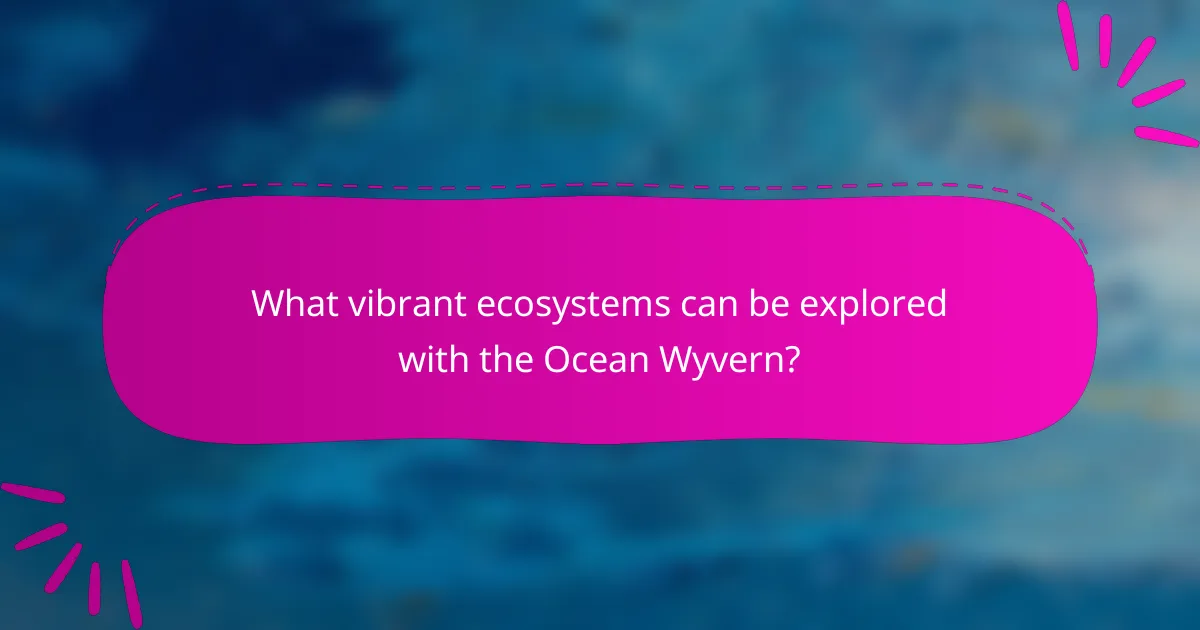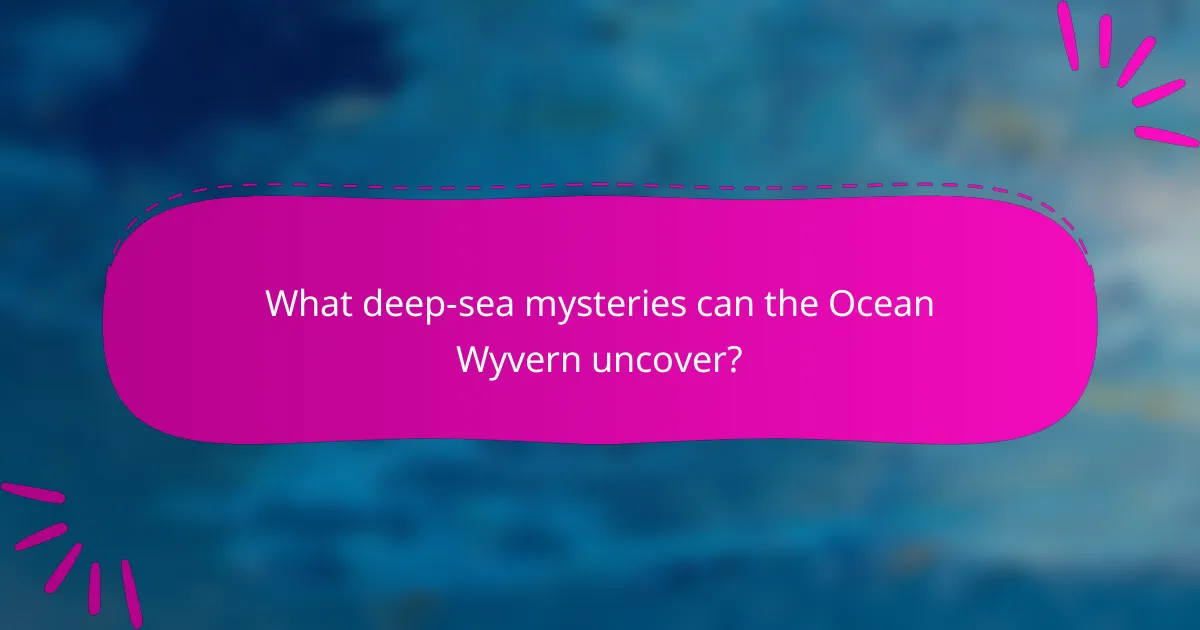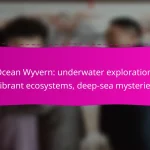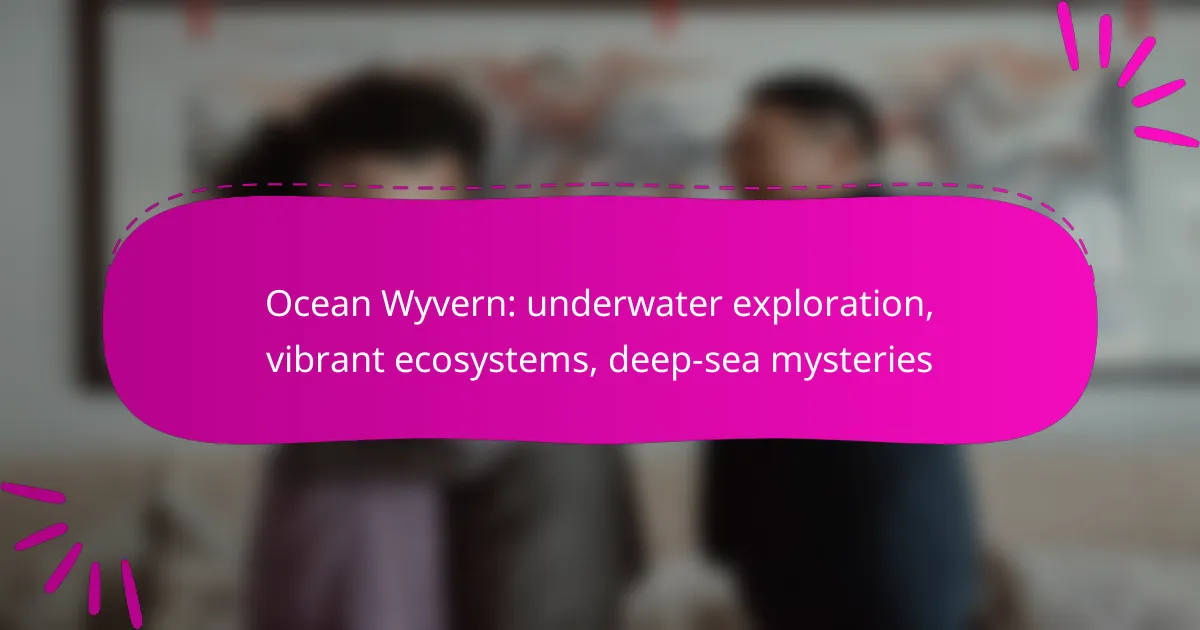The Ocean Wyvern revolutionizes underwater exploration with its state-of-the-art technology, enabling detailed mapping and analysis of marine environments. This innovative vessel uncovers vibrant ecosystems and deep-sea mysteries, revealing the intricate beauty of oceanic biodiversity and the secrets hidden beneath the waves.

How does the Ocean Wyvern enhance underwater exploration?
The Ocean Wyvern significantly enhances underwater exploration by integrating cutting-edge technology that allows for detailed mapping and analysis of marine environments. Its advanced features enable researchers to uncover vibrant ecosystems and deep-sea mysteries with unprecedented efficiency.
Advanced sonar technology
The Ocean Wyvern utilizes advanced sonar technology to create high-resolution maps of the ocean floor. This technology can penetrate various water conditions, allowing for accurate detection of underwater features and marine life.
By employing multi-beam sonar systems, the Ocean Wyvern can cover large areas quickly, making it ideal for both scientific research and commercial applications. This capability is crucial for identifying habitats and assessing biodiversity in different marine ecosystems.
Real-time data transmission
Real-time data transmission is a key feature of the Ocean Wyvern, enabling instant communication with surface teams. This allows researchers to make immediate decisions based on live data, enhancing the effectiveness of underwater missions.
With low-latency communication systems, the Ocean Wyvern can relay information about environmental conditions, species sightings, and other critical data as it is collected. This capability is essential for timely responses to changing underwater conditions.
Autonomous navigation capabilities
The Ocean Wyvern is equipped with autonomous navigation capabilities that allow it to operate independently in complex underwater environments. This feature reduces the need for constant human oversight, enabling longer missions and deeper explorations.
Using advanced algorithms and sensors, the Ocean Wyvern can navigate around obstacles and adjust its path in real-time. This autonomy is particularly beneficial for exploring remote or hazardous areas where human divers cannot safely go.
Durable design for extreme depths
Designed to withstand extreme depths, the Ocean Wyvern features a robust construction that ensures reliability in harsh underwater conditions. Its materials are chosen to resist corrosion and pressure, allowing it to operate effectively at significant depths.
This durability means that the Ocean Wyvern can explore areas of the ocean that are typically inaccessible, providing valuable insights into deep-sea ecosystems and geological formations.
Compatibility with various sensors
The Ocean Wyvern’s design allows for compatibility with a wide range of sensors, enhancing its versatility in underwater exploration. Researchers can easily integrate different instruments for specific tasks, such as environmental monitoring or biological studies.
This adaptability enables the Ocean Wyvern to be customized for various missions, whether it involves collecting water samples, measuring temperature, or conducting biological surveys. Such flexibility is crucial for addressing the diverse challenges of underwater research.

What vibrant ecosystems can be explored with the Ocean Wyvern?
The Ocean Wyvern enables exploration of diverse underwater ecosystems, showcasing the beauty and complexity of marine life. From colorful coral reefs to mysterious deep-sea environments, each ecosystem offers unique insights into oceanic biodiversity.
Coral reefs in the Caribbean
Caribbean coral reefs are among the most vibrant ecosystems, teeming with life and color. These reefs provide habitat for thousands of species, including fish, invertebrates, and marine mammals. The Ocean Wyvern can navigate these shallow waters, allowing for close observation of coral formations and their inhabitants.
When exploring Caribbean reefs, be mindful of the delicate balance of these ecosystems. Avoid touching corals and consider using eco-friendly sunscreen to protect marine life. The best times for exploration are during the dry season, typically from December to April, when visibility is optimal.
Deep-sea hydrothermal vents
Deep-sea hydrothermal vents are fascinating ecosystems found along mid-ocean ridges, where heated water rich in minerals emerges from the ocean floor. These vents support unique organisms, such as tube worms and extremophiles, which thrive in extreme conditions. The Ocean Wyvern can reach these depths, providing access to study these unusual habitats.
Exploring hydrothermal vents requires specialized equipment due to high pressure and low temperatures. Researchers often use remotely operated vehicles (ROVs) to collect samples and data. Be prepared for limited visibility and extreme conditions, which can make navigation challenging.
Underwater kelp forests
Kelp forests are lush underwater ecosystems found in temperate coastal regions, characterized by towering kelp plants that provide shelter and food for various marine species. The Ocean Wyvern can glide through these forests, offering a unique perspective on the interactions between plants and animals. These forests are crucial for carbon sequestration and supporting marine biodiversity.
When exploring kelp forests, pay attention to tidal patterns, as they can affect visibility and accessibility. The best time for exploration is during low tide when the kelp is more exposed. Be cautious of strong currents, which can be prevalent in these areas.
Polar ice cap ecosystems
Polar ice cap ecosystems are unique environments characterized by ice-covered waters and extreme conditions. These regions are home to specialized species, including seals, polar bears, and various seabirds. The Ocean Wyvern can navigate through ice floes, allowing researchers to study these fragile ecosystems up close.
Exploring polar regions requires careful planning due to harsh weather and ice conditions. Ensure that the Ocean Wyvern is equipped for cold temperatures and has adequate insulation. The best time for exploration is during the summer months when ice is thinner and wildlife is more active.

What deep-sea mysteries can the Ocean Wyvern uncover?
The Ocean Wyvern is designed to explore and reveal the secrets of the deep sea, uncovering shipwrecks, unidentified marine species, underwater geological formations, and ancient submerged civilizations. Its advanced technology allows for detailed investigations of these mysteries, contributing to our understanding of oceanic ecosystems.
Shipwreck explorations
The Ocean Wyvern can locate and investigate shipwrecks, which often serve as time capsules of maritime history. These explorations can reveal artifacts and cargo that provide insights into past trade routes and cultural exchanges. Utilizing sonar mapping and remotely operated vehicles (ROVs), the Wyvern can access sites at depths previously thought unreachable.
When exploring shipwrecks, it’s essential to follow local regulations regarding underwater archaeology. Many countries have laws protecting wreck sites, so obtaining the necessary permits is crucial before conducting any exploration.
Unidentified marine species
The deep sea is home to countless unidentified marine species, and the Ocean Wyvern plays a pivotal role in discovering and documenting these organisms. Its advanced imaging technology allows researchers to capture high-resolution images and videos of marine life in their natural habitats, facilitating the identification of new species.
To maximize the chances of discovering new species, researchers should focus on unexplored areas and employ various sampling techniques. Collaborating with marine biologists can enhance the understanding of these species’ ecological roles and conservation needs.
Underwater geological formations
The Ocean Wyvern can map underwater geological formations, such as hydrothermal vents and underwater volcanoes, which are critical to understanding oceanic processes. These formations often host unique ecosystems and provide valuable information about the Earth’s geological history.
When studying geological formations, using multi-beam sonar and submersibles can yield detailed topographical maps. This data is essential for assessing geological hazards and understanding the dynamics of plate tectonics in oceanic regions.
Ancient submerged civilizations
Exploring ancient submerged civilizations is another fascinating aspect of the Ocean Wyvern’s capabilities. Many coastal areas around the world, such as the Mediterranean and the Caribbean, contain remnants of past human settlements that have been submerged due to rising sea levels.
To investigate these sites, researchers should employ a combination of archaeological techniques and modern technology, including underwater drones and ground-penetrating radar. This approach can help uncover artifacts and structures that tell the story of human adaptation to changing environments.

What are the prerequisites for using the Ocean Wyvern?
To use the Ocean Wyvern for underwater exploration, operators must meet specific training, regulatory, and equipment standards. These prerequisites ensure safe and effective deep-sea missions while protecting marine ecosystems.
Training for operators
Operators of the Ocean Wyvern must undergo specialized training that covers both technical skills and safety protocols. This training typically includes simulations, hands-on practice, and knowledge of underwater navigation and communication systems.
Certification programs may vary, but most require a minimum of several weeks of intensive study and practical experience. Operators should also familiarize themselves with emergency procedures and the unique challenges of deep-sea environments.
Regulatory compliance for deep-sea exploration
Compliance with local and international regulations is essential for deep-sea exploration using the Ocean Wyvern. Operators must be aware of laws governing marine conservation, environmental protection, and safety standards.
In many regions, permits may be required for underwater exploration activities. It’s crucial to consult relevant authorities and ensure that all necessary documentation is in place before embarking on a mission.
Equipment compatibility checks
Before using the Ocean Wyvern, operators must perform thorough compatibility checks on all equipment. This includes verifying that sensors, communication devices, and safety gear are suitable for deep-sea conditions.
Regular maintenance and testing of equipment are vital to prevent malfunctions during missions. Operators should create a checklist to ensure that all components meet operational standards and are ready for deployment.










